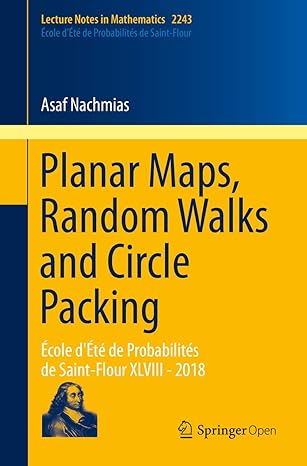
|
FreeComputerBooks.com
Links to Free Computer, Mathematics, Technical Books all over the World
|
|
- Title Planar Maps, Random Walks and Circle Packing
- Authors Asaf Nachmias
- Publisher: Springer; 1st ed. 2020 edition; eBook (Creative Commons Licensed)
- License(s): Creative Commons License (CC)
- Paperback: 132 pages
- eBook: PDF and ePub
- Language: English
- ISBN-10: 3030279677
- ISBN-13: 978-3030279677
- Share This:

|
A planar map is a graph that can be drawn in the plane without crossing edges, together with a specification of the cyclic ordering of the edges incident to each vertex.
This open access book focuses on the interplay between Random Walks on planar maps and Koebe’s circle packing theorem. Entirely self-contained and aimed to fully accompany a single-semester graduate course. Many classical proofs have been simplified and streamlined. Contains numerous useful exercises.
About the Authors- N/A
- Graph Theory
- Algorithms and Data Structures
- Combinatorics and Game Theory
- Discrete and Finite Mathematics
- Operations Research (OR), Linear Programming, Optimization, and Approximation
 Similar Books:
Similar Books:
-
 Maximal Planar Graph Theory and the Four-Color Conjecture
Maximal Planar Graph Theory and the Four-Color Conjecture
Integrate foundational principles with advanced methodologies concerning maximal planar graphs. Offer readers an exceptional examination of graph structures, chromatic polynomials, and the construction and proof techniques of the Four-Color Conjecture.
-
 Random Walks and Electrical Networks (Peter G. Doyle, et al.)
Random Walks and Electrical Networks (Peter G. Doyle, et al.)
A popular account of the connection between Random Walks and electric networks. Electric networks is part of the much broader subject of general network theory which is itself a branch of the mathematical subject of graph theory.
-
 Random Graphs and Complex Networks (Remco van der Hofstad)
Random Graphs and Complex Networks (Remco van der Hofstad)
This rigorous introduction to network science presents Random Graphs as models for real-world networks. Such networks have distinctive empirical properties and a wealth of new models have emerged to capture them.
-
 Graph Theory and Complex Networks (Maarten van Steen)
Graph Theory and Complex Networks (Maarten van Steen)
This book aims to explain the basics of graph theory that are needed at an introductory level for students in computer or information sciences. It also aims to provide an introduction to the modern field of network science.
-
 Probability on Trees and Networks (Russell Lyons, et al.)
Probability on Trees and Networks (Russell Lyons, et al.)
This book is concerned with certain aspects of discrete probability on infinite graphs that are currently in vigorous development. Of course, finite graphs are analyzed as well, but usually with the aim of understanding infinite graphs and networks.
-
 Graph Theory (Reinhard Diestel)
Graph Theory (Reinhard Diestel)
This book covers the core material of the subject with concise yet reliably complete proofs, while offering glimpses of more advanced methods in each field by one or two deeper results, again with proofs given in full detail.
-
 Hypergraph Computation (Qionghai Dai, et al.)
Hypergraph Computation (Qionghai Dai, et al.)
Comprehensive and systematic overview for Hypergraph computation. Rich blend of basic knowledge, theoretical analysis, algorithm introduction, and key applications. Describes hypergraph computation applications in computer vision, medical applications, etc.
-
 Digraphs: Theory, Algorithms and Applications (J. Bang-Jensen)
Digraphs: Theory, Algorithms and Applications (J. Bang-Jensen)
This book is an essential, comprehensive reference of Digraphs covering the theoretical aspects of the subject, focus on applications which include quantum mechanics, bioinformatics, embedded computing, and the travelling salesman problem.
-
 Graph Theory - Advanced Algorithms and Applications
Graph Theory - Advanced Algorithms and Applications
Not only will the methods and explanations help you to understand more about graph theory, but you will find it joyful to discover ways that you can apply graph theory in your applications or scientific research.
-
 Algorithmic Graph Theory (David Joyner, et al)
Algorithmic Graph Theory (David Joyner, et al)
This is an introductory book on algorithmic graph theory. Theory and algorithms are illustrated using the Sage open source mathematics software. It's especially suitable for computer scientists and mathematicians interested in computational complexity.
-
 Explorations in Algebraic Graph Theory (Chris Godsil, et al.)
Explorations in Algebraic Graph Theory (Chris Godsil, et al.)
This book aims to express properties of graphs in algebraic terms, then to deduce theorems about them. It tackles the applications of linear algebra and matrix theory to the study of graphs; algebraic constructions such as adjacency matrix, using the Sage.
-
 An Introduction to Combinatorics and Graph Theory
An Introduction to Combinatorics and Graph Theory
This book walks the reader through the classic parts of Combinatorics and graph theory, while also discussing some recent progress in the area: on the one hand, providing material that will help students learn the basic techniques.
-
 Advances in Graph Algorithms (Ton Kloks, et al.)
Advances in Graph Algorithms (Ton Kloks, et al.)
This is a book about some currently popular topics such as exponential algorithms, fixed-parameter algorithms and algorithms using decomposition trees of graphs which is one of focuses of the book - occupied a whole chapter.





